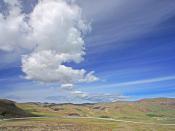I. Purpose The purpose of our experiment was to find how diet affects the growth rate of Macrobachium rosenbergii. The two variables included within our experiment were the use of two different food particles: protein and fatty substances with a separation net to separate the pairs of shrimp. The goal of our experiment was to find where shrimp will grow the largest, in a region where the particles of food are fatty, or where the particles are high in protein.
II. Background Shrimp are structurally similar to lobsters and crayfish, but they lack enlarged pincers and are flattened laterally instead of horizontally. The animals are usually transparent or are green or brown in color. They have thick-muscled abdomens, which they contract rapidly in making their sudden, backward-swimming escapes. (The shrimp meat served in numerous dishes, an important product of the fishing industry, is the curved muscle extracted from the abdomen.)
The animals have eight pairs of appendages on the thorax: the front three, called maxillipeds, are mouthparts used for feeding; the rear five, called pereipods, are used for walking. The abdomen contains five pairs of swimming legs, called pleopods, and a fanlike tail.
Many small shrimp are harvested from the cold waters of Iceland, Greenland, and Canada. Today, cultured or farmed marine shrimp play an important role in supplying the world's shrimp demand. Total wild and farmed shrimp harvest accounts for less than 5 percent of the total world fisheries harvest. Even so, shrimp has a very high commercial value and is the most important species group in world fisheries trade. The United States spends more on shrimp purchased from around the world than on any other imported fishery product.
The amount of shrimp consumed in the US has doubled in the last decade to some one billion lbs a...


